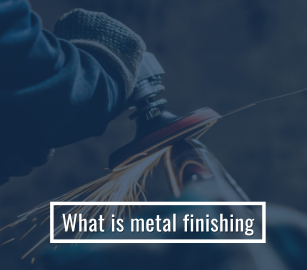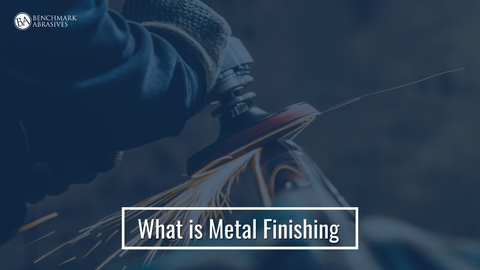
What is Metal Finishing

You'll probably notice one or more items in your immediate surroundings made of metal. This starts with the computer you're using to read this article. For thousands of years, metal has been an integral part of human life and has contributed significantly to almost every technological advancement. Imagine how different our lives would be if we didn't use metals in today's products, including jewelry, dental fillings, nuts, and bolts.
We regularly use dozens of different metals in various forms. Examples include "precious" metals like gold, silver, platinum, and palladium, which are relatively uncommon, as well as copper, tin, zinc, lead, and nickel. These are all naturally occurring elements taken from the planet's crust. Each has unique qualities that benefit man. Each metal type must be strengthened to maximize its usefulness because it has inherent flaws. Industrial metal polishing is useful in this situation.
INDUSTRIAL METAL FINISHING: WHAT IS IT?
Applying a metal coating to the surface of a metallic part, commonly referred to as a substrate, is called "metal finishing." It could also entail a procedure for polishing, cleaning, or generally enhancing a surface.
Metal finishing sometimes includes electroplating, depositing metal ions onto a substrate while employing an electric current. "plating" and "metal finishing" are occasionally used synonymously.
The metal finishing industry uses various processes, and each one benefits the user. Industrial metal finishing can be used for a variety of beneficial applications, such as:
- Reducing corrosion's effects.
- Serving as a priming coat to encourage paint adherence.
- Enhancing wear resistance and strengthening the substrate.
- Minimizing friction impact.
- Enhancing a part's look.
- Improving solderability.
- Creating an electrically conductive surface.
- Enhancing chemical resistance.
- Cleaning, polishing, and eliminating surface flaws.
Examining some of the most widely applied industrial metal finishing methods will help us understand how metal finishing functions.
ELECTROPLATING: WHAT IS IT?
The process of depositing a metal or metal alloy onto the surface of a substrate is known as electroplating, sometimes known as electrodeposition. An electric current is run through a liquid (a "bath") with dissolved ions of the metal and the substrate. The item works as a cathode, drawing metal ions from the plating bath. A pretreatment process before plating includes washing, rinsing, and stripping.
Rack plating, where the components are attached to a jig, and barrel plating, where multiple smaller components tumble inside a barrel-shaped cage, are two common bulk electroplating techniques.
Plastic and non-metallic materials can be coated with electroplating and metallic surfaces. However, this procedure is very challenging and requires specialized plating knowledge.
ELECTROLESS PLATING
Like electroplating, electroless plating involves submerging the substrate in a liquid solution that includes the desired metal, nickel or copper. How deposition takes place distinguishes them. Metal coatings are applied chemically, not electrically. The plating bath normally uses the source metal and a complexing agent to protect the metal solution. It also contains other chemicals to maintain stability and extend bath life.
PASSIVATION
Passivation is sometimes used as a post-treatment plating, typically offering more corrosion protection. Passivation is the process of covering metal surfaces with metal oxide, which can delay the development of rust. Passivates come in a variety of colors, which improve the finished part's aesthetic appeal.
CLADDING
In the mechanical cladding process, the substrate and the metal layer are bonded using pressure and heat. Compared to electroplating or electroless plating, cladding offers a thicker metal layer. It also calls for a less rigorous preparation procedure. Cladding is more expensive than plating.
CASE HARDENING
Making a metal surface tougher is one method of protecting it. Case hardening, a method of industrial metal finishing, can achieve this. Through surface modification, case hardening increases protection. This can be accomplished using any number of processes, including micro casing, carburizing, and nitriding.
While the underlying metal remains soft, these methods can yield the desired stiff casing. The protective case will improve the underlying workpiece's toughness and wear resistance.
HOT BLACKENING
Hot blackening coats automotive parts, guns, and military applications with a dark protective coating with a matte black finish. Hot blackening can also improve metal parts' abrasion resistance. A thin layer of black oxide is added to the substrate's surface during heat blackening.
This procedure involves passing parts through numerous tanks filled with cleaning solutions, corrosives, and coolants. Hot blackening is best suited to smaller items because it is often done in big batches.
POWDER COATING
Powder coating involves applying dry powder to metal items instead of liquid. Powder coatings typically offer more thickness than liquid coatings. The powder coating process combines chemicals such as pigments, cures, flow modifiers, leveling agents, and other additives.
After that, the powder is electrostatically deposited on the substrate's surface. The final stage is to cure the components in an oven specifically built, which causes a chemical reaction and creates high-link density. Several polymers and other non-metallic substrates can also receive powder coatings.
ELECTROPOLISHING: WHAT IS IT?
The electrochemical metal finishing procedure known as electropolishing is considered the antithesis of electroplating. Metal ions are deposited on the substrate surface during electroplating. Electropolishing produces a smooth, streamlined surface by removing metal ions from the substrate. The object can act as an anode by being submerged in an electrolyte bath, which is how this is performed.
The item is also linked to a terminal that acts as the cathode and DC power sources. Electropolishing is used to polish difficult-to-reach places, eliminate peaks and valleys, and remove burrs or small amounts of dirt from the surface. In rare circumstances, it can even be used to reduce the size of a portion.
POLISHING BUFFS
Buff polishing can clean and smooth substrate surfaces, just like electropolishing. However, buff polishing does not create electrochemical reactions. Instead, a machine with a cloth wheel buffs the surface, creating a result comparable to polishing a car after waxing it. Buff polishing is used to give metallic objects a shiny, attractive appearance.
MASS FINISH
Bulk polishing of items is made affordable by mass finishing, commonly called mechanical surface finishing. In reality, mass finishing refers to various procedures that simultaneously clean, break, smooth, and polish tiny pieces uniformly. Production times may reduce dramatically as a result. Tumble finishing and vibratory finishing are other common bulk finishing methods. Media application, made of aluminum, steel, plastic, or aluminum, is a common step in mass-finishing procedures. The preferred process outcome determines the medium used.
SHOT PEENING
Shot peening can significantly improve durability and longevity by decreasing metal fatigue and stress, minimizing corrosion-related failures, and enhancing durability. Consider the idea used using a ball-pen hammer to comprehend how shot peening functions. Metal objects develop dimples when struck with a hammer. The object's surface will strengthen due to compression stress.
Shot peening involves blasting tiny projectiles known as shots with specialized equipment. Ceramics, metal, glass, and other materials can all be used to make projectiles. Plasticity, or long-lasting surface distortion, is brought on by compression.
ABRASIVES BLASTING
Cleaning and finishing can be combined into one operation using abrasive blasting, sometimes called sandblasting or beads blasting. This saves time and money. With abrasive blasting, the necessary cleaning, polishing, or finishing action is carried out by projecting a medium onto the part's surface using high-pressure compressed air.
Sand, silicon carbide, glass beads, aluminum steel grits or shot, and organic materials like walnut shells or corn cobs are just a few examples of the many different types of media that can be employed. Softer materials are typically used on surfaces more prone to damage, whereas harsher media are typically employed when more aggressive cleaning action is necessary. The pressure can also be changed to meet precise cleaning or finishing needs.
SODA BLASTING
Similar principles govern both abrasive and soda blasting. The main distinction is that baking soda is launched onto an object's surface rather than an abrasive material. Soda blasting is a strong technique for eliminating grease, oil, rust, paint, and other surface pollutants. However, compared to abrasive blasting, it also offers gentler cleaning action. Surfaces prone to scratching are typically soda-blasted. Another option to remove rust, oxidation, paint, and other unwanted surface contaminants is wire power brushes. Abrasive industries widely utilize them.
TUMBLE SLURRY BLASTING
Because tumble slurry blasting uses hot water to achieve cleaning or surface preparation results, it is called wet blasting. Wet blasting is a three-step technique that starts with a hot alkali water wash to prepare the surface. This is followed by applying an abrasive slurry and a final rinse with alkali hot water. In contrast to conventional blasting techniques, using a blast wheel, tumble slurry blasting propels the slurry at high speed. Degreasing, grease and oxide removal, and other common wet blasting applications.
VIBRATORY FINISHING
Rough edges and other surface flaws can be removed effectively with vibratory finishing. Parts are put into a bowl or tub that also holds media pellets. The media and components rub against one another because the bowl vibrates when activated, producing the intended effect. Vibratory finishing applications for smaller parts include edge-breaking, cleaning, descaling, burnishing, and polishing.
CLEANING OF PARTS
Parts must be regularly cleaned properly to remove pollutants before other industrial metal finishing procedures. Ultrasonic washing uses high-frequency sound waves to provide a vigorous scrubbing motion to remove obstinate pollutants and debris and is frequently used to clean parts.
Continuous flow washing, a three-step procedure in which components are transported between stations for washing, rinsing, and drying, is another efficient way of cleaning parts. Both procedures are excellent for quickly and effectively cleaning many tiny parts.
FINDING THE BEST INDUSTRIAL METAL FINISHING METHOD
When selecting an industrial metal finishing method, several criteria should be considered. You must account for production rates. For instance, you must select a procedure that meets your stringent production requirements if your organization requires a short turnaround time. Another factor to consider is the metal's or other substrate material's hardness. An excessively abrasive treatment could harm the component, while one that is too soft might not produce the desired result.
Cost is, of course, a major consideration. Your business can save money by investigating all the price options. For instance, you might not be able to afford electroplating with precious metal. However, using a less expensive metal as a substitute might give you the same outcomes at a lower overall cost.



































































